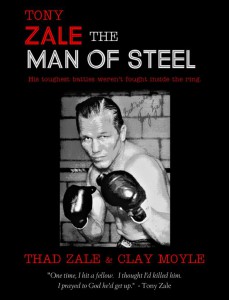Book Review: Man of Steel
 Review by Ian “The Boxing Historian” Murphy
Review by Ian “The Boxing Historian” Murphy
Tony Zale’s story was long overdue. A greater man even than he was a fighter, the appropriately named Man of Steel showed just as much moxy and ferocious tenacity in life as he did in the squared circle. Most fans know of his ring exploits and that Zale was a nice guy outside of it, but his story runs deeper than that. He is the American Dream personified, a son of immigrants coming to manhood during the Great Depression and overcoming economic hardship through discipline forged in the crucible of hard times. His life is documented in Man of Steel by his nephew Ted Zale and respected boxing historian Clay Moyle. Much has been said about Zale the fighter (and he was truly formidable!), but not nearly enough has been said about him as a man.
Tony Zale was born Anthony Florian Zaleski in Gary, Indiana on May 29, 1913. His place of birth is partly responsible for his nickname, (and also because he was nearly unbreakable in the ring), as Gary was known for its steelworks in those days. He was the second youngest of seven children to Polish immigrants and lost his father at age two in a bicycle accident. Growing up Tony was especially close to his older brothers Joe and John Zaleski, both of whom were good amateur boxers, and each elder Zale brother captured the 1920s equivalents of Golden Gloves titles.The ring successes of his brothers were not lost on young Anthony, and they each taught him some valuable lessons in the ring. He inherited his power and big left from Joe, and his good footwork and movement from John. Tony proved to be a natural. By the time Tony was a teenager, they wanted nothing to do with him in the ring.
While growing up in the 1920s and 1930s, Tony Zale learned the core values that would stick with him for his whole life: faith in God, loyalty to his family, and a tremendous work ethic. These traits helped him overcome adversity in the ring and in life, and let me tell you, Tony Zale had more than his share. We’ll leave the bulk of Zale’s ring career out of this review, as it is profiled in great detail in the book. What is truly remarkable is how Tony chose to live his life in the face of much personal turmoil and heartache. He was a devout family man, but his first wife was bent on keeping him away from his daughters. To someone who held duty to family in such high regard, it must have been particularly difficult and heartbreaking not being around to raise his children. In addition to the ongoing family issues, Zale was in danger of becoming a cautionary tale of the ring, as his ring earnings were not enough to sustain him when his career ended. He lived in near poverty for years following his retirement , acting as Security in an unheated apartment building in a rough neighborhood. What kept Tony going in these troubled times was his strong faith and passion for mentoring young people.
For decades, Tony Zale dedicated much of his time to the Chicago Catholic Youth Organization and Parks Department. Here Tony used his gift for communicating with the youngsters to give them hope and help them become more than just another inner-city statistic. He taught them boxing and how to be men of integrity, honor, and substance. He led by example, and walked the walk. Zale may have been a quiet and humble man, but his actions spoke louder than words. He mentored literally thousands of young people through his efforts with the C.Y.O and Parks Department. It is without a doubt that while Tony was rightfully proud of his accomplishments in the ring, he was much more proud of his time spent mentoring the youth of Chicago. Thad Zale and Clay Moyle do a tremendous job in showcasing both aspects of The Man of Steel. In the words of one of those young men who Tony mentored, Aram Alkhazoff: “Tony Zale helped me as a kid growing up in Chicago. He remains one of the greatest men I’ve ever known. Our whole neighborhood looked up to Tony Zale”.
Tony Zale’s ferocious fighting spirit inside the ring was belied only by his gentility outside it. He was truly a perfect example of “The Greatest Generation”, displaying a quiet, yet unbreakable strength of will and resiliency in the face of difficult and trying circumstances. Mr. Zale has been gone for almost twenty years, but through the efforts of Ted Zale, his family, and Clay Moyle, Tony’s inspiring story has come to light. In addition, a screenplay about Tony’s life is being written by his great-niece, actor and writer Haley Zale. I never met Tony, but in reading Man of Steel, I almost feel like I did, and it only reinforced my respect for the man and what he stood for.
Purchase your copy here.
[si-contact-form form=’2′]

